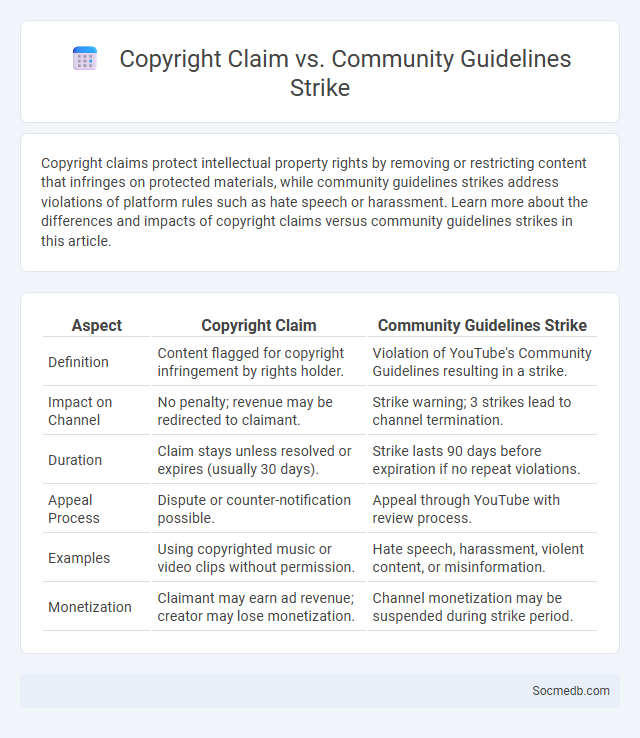
Photo illustration: Copyright Claim vs Community Guidelines Strike
Copyright claims protect intellectual property rights by removing or restricting content that infringes on protected materials, while community guidelines strikes address violations of platform rules such as hate speech or harassment. Learn more about the differences and impacts of copyright claims versus community guidelines strikes in this article.
Table of Comparison
| Aspect | Copyright Claim | Community Guidelines Strike |
|---|---|---|
| Definition | Content flagged for copyright infringement by rights holder. | Violation of YouTube's Community Guidelines resulting in a strike. |
| Impact on Channel | No penalty; revenue may be redirected to claimant. | Strike warning; 3 strikes lead to channel termination. |
| Duration | Claim stays unless resolved or expires (usually 30 days). | Strike lasts 90 days before expiration if no repeat violations. |
| Appeal Process | Dispute or counter-notification possible. | Appeal through YouTube with review process. |
| Examples | Using copyrighted music or video clips without permission. | Hate speech, harassment, violent content, or misinformation. |
| Monetization | Claimant may earn ad revenue; creator may lose monetization. | Channel monetization may be suspended during strike period. |
Understanding YouTube’s Enforcement Actions
YouTube enforces its policies through automated systems and human reviewers to maintain community guidelines, removing content that violates rules related to hate speech, misinformation, and harmful behavior. Your channel may face strikes, temporary suspensions, or permanent bans depending on the severity and frequency of violations. Staying informed about YouTube's enforcement updates helps you create content that complies with platform standards and avoid penalties.
What Is a Copyright Claim?
A copyright claim occurs when someone asserts ownership over original content shared on social media, protecting their intellectual property rights. You should understand that such claims can result in content removal, muted audio, or monetization changes on your posts. Recognizing what constitutes a copyright claim helps you avoid legal issues and maintain control over your digital content.
The Impact of Copyright Claims on Your Channel
Copyright claims significantly affect your social media channel by restricting content visibility and limiting monetization opportunities on platforms like YouTube and Facebook. Repeated claims can lead to strikes or account suspensions, reducing audience trust and engagement. Understanding fair use policies and using original or licensed content helps maintain channel growth and protect your digital presence.
Defining a Community Guidelines Strike
A Community Guidelines strike occurs when your content violates the platform's established rules, leading to temporary restrictions on your account's features. Strikes are recorded to monitor repeated offenses, which can result in escalating penalties or account suspension. Understanding how these strikes are assessed enables you to maintain compliance and protect your social media presence.
Causes and Consequences of Community Guidelines Strikes
Community guidelines strikes on social media often result from violations such as hate speech, misinformation, or inappropriate content, aiming to maintain platform safety and user integrity. These strikes can lead to temporary or permanent restrictions on your account, including limited posting abilities or outright suspension. Repeated offenses may harm your online reputation and reduce audience engagement, impacting your overall digital presence and influence.
What Is a Copyright Strike?
A copyright strike is a formal complaint issued on social media platforms when copyrighted content is used without permission, leading to the removal of the infringing material. Platforms like YouTube and Instagram enforce copyright strikes to protect intellectual property rights and prevent unauthorized use of videos, music, or images. Receiving multiple copyright strikes can result in account suspension or termination, emphasizing the importance of respecting copyright laws in digital content sharing.
Differences Between Copyright Claims and Strikes
Copyright claims on social media typically result in content being muted, blocked, or demonetized without affecting your account status, allowing you to retain full platform access. In contrast, copyright strikes indicate repeated or severe violations, leading to account restrictions, suspension, or termination when accumulating multiple strikes. Understanding the differences between claims and strikes helps you manage your content responsibly and protect Your social media presence effectively.
Copyright Strike vs Community Guidelines Strike: Key Differences
A Copyright Strike occurs when copyrighted content is used without permission, leading to content removal or channel penalties on platforms like YouTube. In contrast, a Community Guidelines Strike relates to violations of platform rules regarding behavior, harassment, or harmful content. Copyright Strikes directly address intellectual property issues, while Community Guidelines Strikes focus on maintaining safe and respectful online environments.
How to Resolve Copyright and Community Guidelines Issues
To resolve copyright and community guidelines issues on social media, you should first thoroughly review the platform's policies and identify the specific violation. You can submit a counter-notification or appeal if you believe your content was wrongfully removed, ensuring to provide clear evidence supporting your claim. Protect your account by regularly monitoring for unauthorized use of your content and promptly addressing any infringements to maintain compliance.
Protecting Your Channel from Future Strikes
Protecting your social media channel from future strikes requires consistent adherence to platform guidelines and proactive content monitoring. Implementing automated tools can help detect potential copyright infringements or policy violations before posting. Regularly reviewing updates from the social media service ensures your channel stays compliant and avoids penalties.
 socmedb.com
socmedb.com